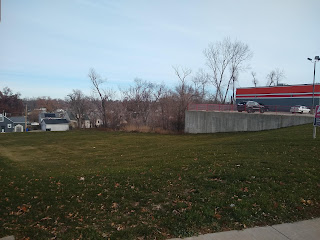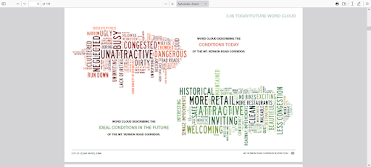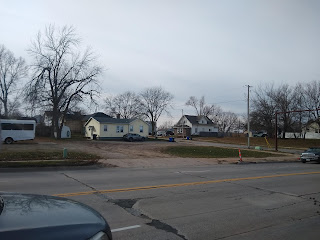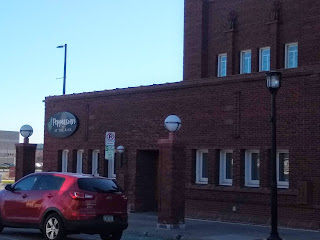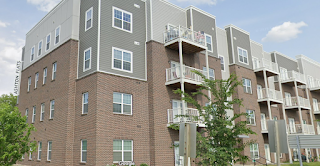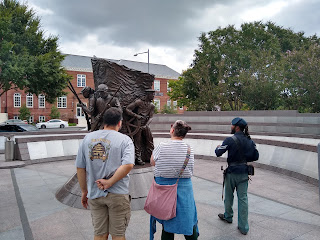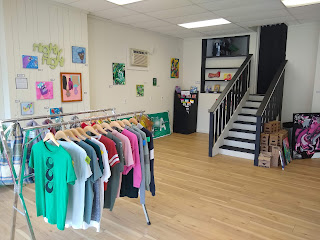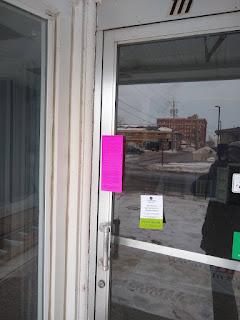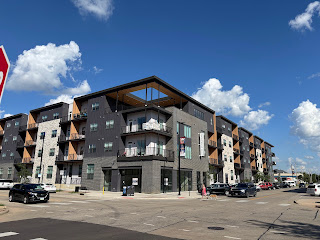 |
| City Manager Jeff Pomeranz in Greene Square, October 2022 |
The Cedar Rapids City Council approved the 2023 Downtown Vision and Action Plan at their December 5 meeting. The plan contains a number of goals and initiatives intended to build on the success Downtown Cedar Rapids has had since 2008.
The plan is a joint project of the city, the Cedar Rapids Metro Economic Alliance (including the Downtown District), Linn County, and the 2001 Development Group. It has three broad goals (p. 10):
- Embrace the Cedar River. [Sure! Can't hurt.]
- Ensure Downtown is activated and vibrant. [This seems to be saying the obvious in a downtown plan, but the details show the authors are serious about achieving a 24-hour downtown.]
- Improve connectivity within Downtown and to adjacent districts and neighborhoods. [Improved connectivity is critical to whether Downtown continues its positive direction. Connections broaden opportunities for downtown residents to access things they need and increase the nearby supply of workers and shoppers for Downtown businesses. The better the connections, not only does success expand but so does the area of the city where it is possible not to rely on motor vehicles for everything.]
 |
| Pullman Lofts: Apartments in what once was an office building |
The market assessment that informed the vision plan notes:
New multi-family residential construction could nearly double the population of Downtown and the Primary Market Area over the next several years, as residential development projects under construction or planned could yield over 800 new residential units within the next several years.... Housing will continue to be a strong market for Downtown moving forward. In line with national trends, there will likely be additional demand for more downtown housing options at more price points. (7)
More residents would contribute to the Goal #2 strategies of enlivening the storefront economy and improving perceptions of safety (80-84), though the plan doesn't claim these benefits. The specific housing initiatives don't come until strategy #6, but include attracting a diversity of housing types, streamlining office-to-housing building conversions, and looking for housing options within an envisioned manufacturer/maker hub. In particular, city incentives for office building conversions in a focused area are credited with fueling a resurgence in Cleveland's downtown ("America's Best Example" 2023).
 |
| Downtown trolley, Little Rock AR |
Goal #2 is Jane's favorite, but there is much in Goal #3 that she commends (85-87): the prospect of a circular trolley, an accessibility audit, attention to trails, attention to the dead zones ("underways") under the interstate, and promoting bicycling. We aleady are a couple segments away from having a trails system that would be really functional for cycle commuting from all over the metro.
Jane is attentive to diversity and inclusion, and notes elements of the "rising tide lifts all boats" variety that could help those on the lower end of the economic ladder: job creation and retention, playground equipment, bicycle trail connections, housing resources and services, and even the riverside parks and special programming if they're free.
...but Elizabeth Bennet is not sold
Elizabeth, like all good urbanists, is all about connections, but she's cautious about granting approval before she sees who we're fixing to connect to. She notes that you would never realize, from the vision plan, that there are residential neighborhoods within half a mile of Downtown--Wellington Heights, Oak Hill Jackson, the Taylor area, and Mound View are not mentioned. The MedQuarter, New Bohemia, Czech Village, and Kingston will be invited to collaborate on programming, promotions and signage--surely useful, but not life-changing.
Elizabeth allows that Jane's identified some good ideas under Goal #2, but would like to see even more focus on housing. Only two of 36 initiatives in this section relate to housing supply, and it isn't blessed by being raised to the level of a strategy. Two more initiatives relate to homelessness; these are part of the "safe and welcoming" strategy. "Safe and welcoming" for whom?
[Homelessness is a surging problem in cities everywhere, or maybe it would be better said to be multiple surging problems (see Corinth 2023, DeParle 2023). The unhoused population is much more than the people you see hanging out in Greene Square. Initiative 2.2.2 proposes effectively ending homelessness with establishment of a Local Oversight Board and staff person to monitor performance on a community-wide basis, ensuring efficient and effective use of resources and continued collaboration with social service providers... This can be read by Jane as serving the unhoused who live among us, after the model of Housing First in Houston (McLean 2022, Kristof and Weinberger 2023), or read by Elizabeth as serving visitors by reducing the appearance of disorder their visible presence creates. We need to do both! And I hope we will. Unfortunately the city's credibility on this issue is not high after last winter's destruction of a homeless encampment south of New Bohemia.]
There's a lot more about parking than housing. Neither Elizabeth nor I are so naive to say that parking is not very important, even critical to the near-term. But there are downsides to prioritizing parking that need to be acknowledged and addressed. It can't be your whole plan, but here it is. Saturday nights in our resurgent Downtown now feature multiple big events along with restaurants and small venues, which leads to good problems, but to resolve these situations the best we seem able to do is better parking.
 |
| The bus system provides extensive coverage of the city at the expense of service |
Transit isn't even part of the solution. It barely gets mentioned in the vision plan. The downtown circulator (3.1.1.) is a very very good idea, if we can figure out optimal frequency and coverage. We will also try to persuade downtown workers to use transit (3.1.3). This will fail, says Elizabeth, who's seen other such initiatives fail since at least the 1990s. Why will it fail? Because transit in Cedar Rapids is inconvenient and unreliable. It may be the best we can do with this budget and this residential pattern, but very few people will ever choose transit unless the system is redesigned. That should have been part of this vision.
What in the vision plan addresses diversity and inclusion? Poor people and marginalized groups surely can benefit from some of the initiatives,but because of their resources and status they are often not as well positioned to take advantage of them. We could have used some more specific diversity initiatives to include the poor in the vision of Downtown's future. But the dominant relationships are with consumers, and that favors those with market power.
 | |
| Coffeehouses like the Early Bird (now Craft'd) are | part of the social city |
In August 2020, as I sat with my mask on amidst the destruction wrought by our derecho, waiting for someone with practical skills to haul way the debris and reconnect the electricity, I compared four versions of the city's future: the social city, the economic city, the healing city, and the creative city. While all four dimensions are important, I expressed then a preference for the primacy of the social city. Communities properly-constructed are inclusive, and thus extend opportunities outward, and the diligent and generous Jane Bennet can find that spirit in this Downtown vision plan.
But mostly what's here is the economic city. When Elizabeth describes the vision as "a lot like Downtown today, but with more parking and fewer homeless people," it's hard to disagree. The Downtown vision is rooted in the assumption that the important people will always be the ones who are driving here to spend or make money, and that's a problem.
SEE ALSO
"10th Anniversary Post: Downtown," Holy Mountain, 18 November 2023
Arian Horbovetz, "The Big Urban Mistake: Building for Tourism vs. Livability," Strong Towns, 5 December 2017
Marissa Payne, "Cedar Rapids Has a Vision for Downtown," Cedar Rapids Gazette, 5 December 2023, 1A, 8A
Quint Studer, "Want to Make Housing More Affordable? Start by Building Neighborhoods Not Just Buildings," Strong Towns, 12 June 2020
HT John Herbert for the Studer article!











